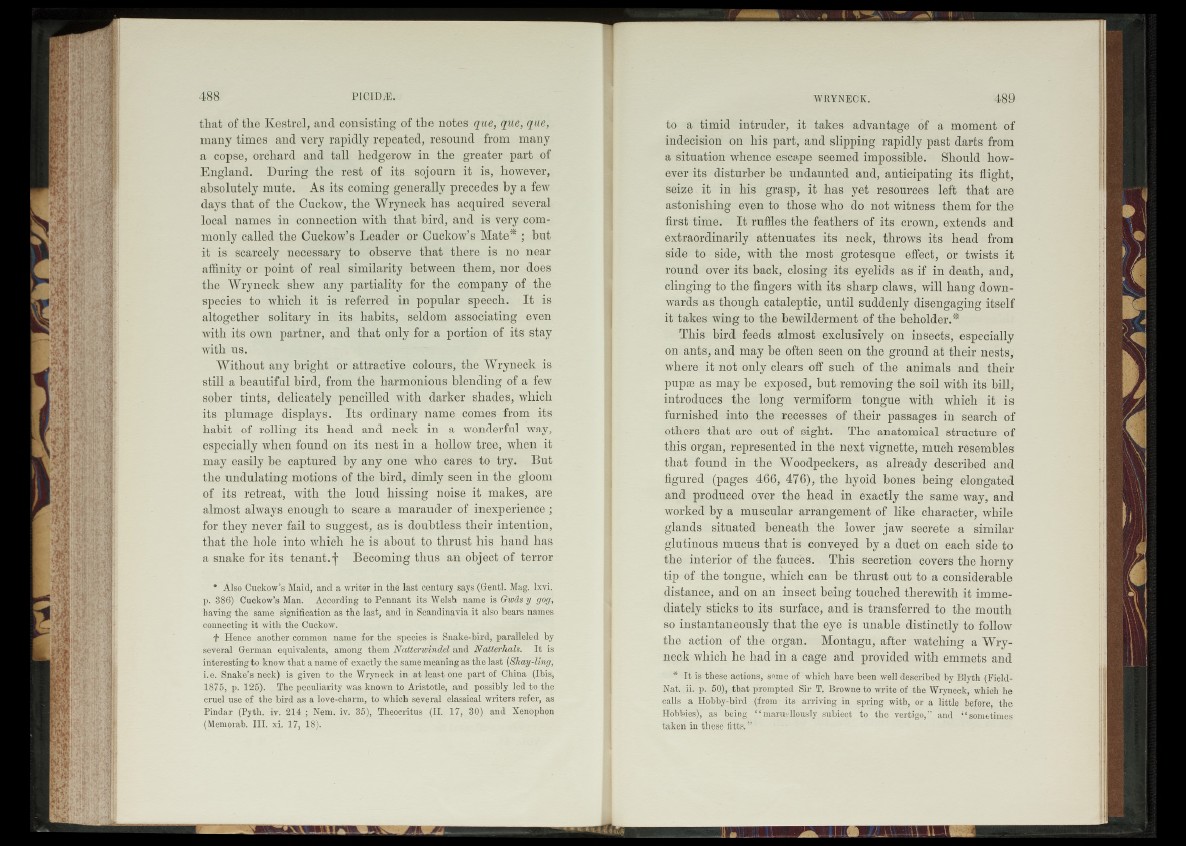
that of the Kestrel, and consisting of the notes que, que, que,
many times and very rapidly repeated, resound from many
a copse, orchard and tall hedgerow in the greater part of
England. During the rest of its sojourn it is, however,
absolutely mute. As its coming generally precedes hy a few
days that of the Cuckow, the Wryneck has acquired several
local names in connection with that bird, and is very commonly
called the Cuckow’s Leader or Cuckow’s Mate* ; hut
it is scarcely necessary to observe that there is no near
affinity or point of real similarity between them, nor does
the Wryneck shew any partiality for the company of the
species to which it is referred in popular speech. It is
altogether solitary in its habits, seldom associating even
with its own partner, and that only for a portion of its stay
with us.
Without any bright or attractive colours, the Wryneck is
still a beautiful bird, from the harmonious blending of a few
sober tints, delicately pencilled with darker shades, which
its plumage displays. Its ordinary name comes from its
habit of rolling its head and neck in a wonderful way,
especially when found on its nest in a hollow tree, when it
may easily he captured by any one who cares to try. But
the undulating motions of the bird, dimly seen in the gloom
of its retreat, with the loud hissing noise it makes, are
almost always enough to scare a marauder of inexperience ;
for they never fail to suggest, as is doubtless their intention,
that the hole into which he is about to thrust his hand has
a snake for its tenant, f Becoming thus an object of terror
* Also Cuckow’s Maid, and a writer in the last century says (Gentl. Mag. lxvi.
p. 386) Cuckow’s Man. According to Pennant its Welsh name is Gwds y gog,
having the same signification as the last, and in Scandinavia it also bears names
connecting it with the Cuckow.
*f* Hence another common name for the species is Snake-bird, paralleled by
several German equivalents, among them Natterwindel and Natterhals. I t is
interesting to know that a name of exactly the same meaning as the last (Shay-ling,
i.e. Snake’s neck) is given to the Wryneck in at least one part of China (Ibis,
1875, p. 125). The peculiarity was known to Aristotle, and possibly led to the
cruel use of the bird as a love-charm, to which several classical writers refer, as
Pindar (Pyth. iv. 214 ; Hem. iv. 35), Theocritus (II. 17, 30) and Xenophon
(Memorab. III. xi. 17, 18).
to a timid intruder, it takes advantage of a moment of
indecision on his part, and slipping rapidly past darts from
a situation whence escape seemed impossible. Should however
its disturber be undaunted and, anticipating its flight,
seize it in his grasp, it has yet resources left that are
astonishing even to those who do not witness them for the
first time. It ruffles the feathers of its crown, extends and
extraordinarily attenuates its neck, throws its head from
side to side, with the most grotesque effect, or twists it
round over its back, closing its eyelids as if in death, and,
clinging to the fingers with its sharp claws, will hang downwards
as though cataleptic, until suddenly disengaging itself
it takes wing to the bewilderment of the beholder.*
This bird feeds almost exclusively on insects, especially
on ants, and may be often seen on the ground at their nests,
where it not only clears off such of the animals and their
pupae as may be exposed, but removing the soil with its bill,
introduces the long vermiform tongue with which it is
furnished into the recesses of their passages in search of
others that are out of sight. The anatomical structure of
this oi’gan, represented in the next vignette, much resembles
that found in the Woodpeckers, as already described and
figured (pages 466, 476), the hyoid bones being elongated
and produced over the head in exactly the same way, and
worked by a muscular arrangement of like character, while
glands situated beneath the lower jaw secrete a similar
glutinous mucus that is conveyed by a duct on each side to
the interior of the fauces. This secretion covers the horny
tip of the tongue, which can be thrust out to a considerable
distance, and on an insect being touched therewith it immediately
sticks to its surface, and is transferred to the mouth
so instantaneously that the eye is unable distinctly to follow
the action of the organ. Montagu, after watching a Wryneck
which he had in a cage and provided with emmets and
* It is these actions, some of which have been well described by Blyth (Field-
Nat. ii. p. 50), that prompted Sir T. Browne to write of the Wryneck, which he
calls a Hobby-bird (from its arriving in spring with, or a little before, the
Hobbies), as being “ marudlously subiect to the vertigo,” and “ sometimes
taken in these fitts. ”